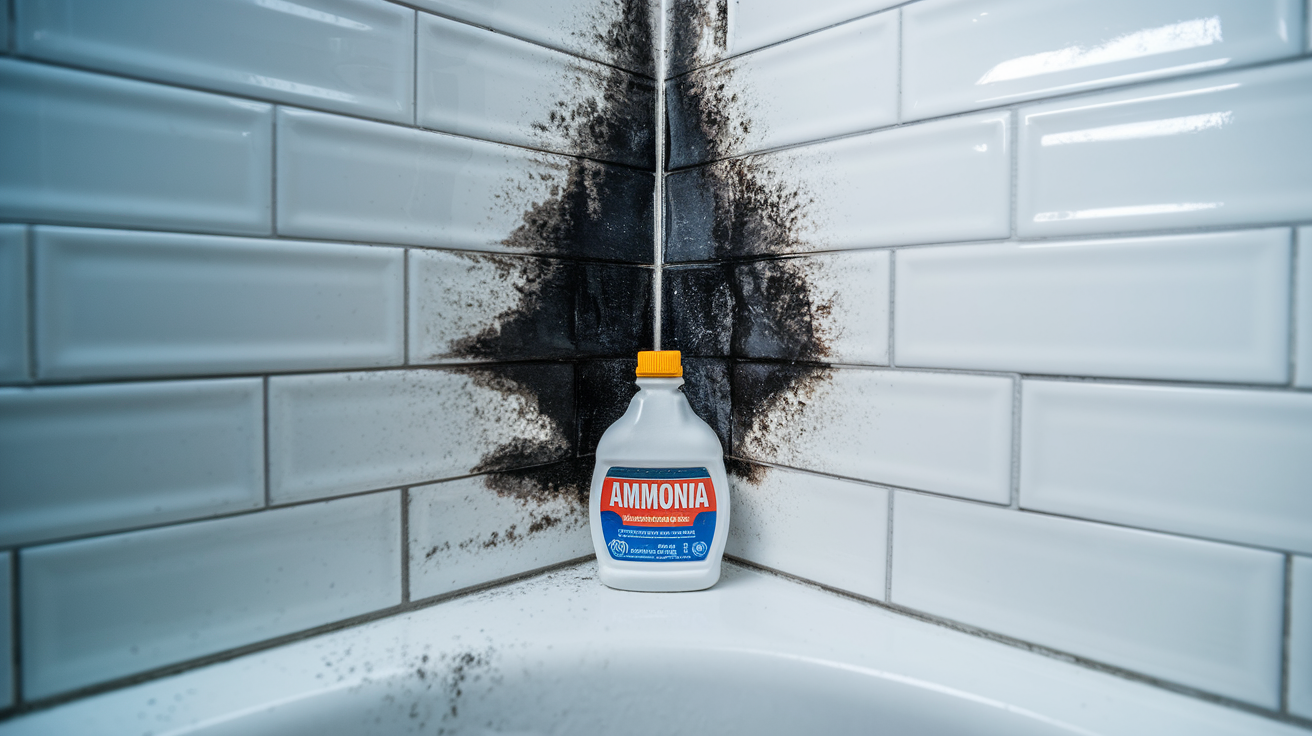Does Ammonia Kill Mold Effectively? [Learn How Fast It Can]
TL;DR: Ammonia effectively kills mold on non-porous surfaces. A 1:10 solution of ammonia to water is recommended for cleaning, but soaking should not exceed overnight. Ammonia creates an environment inhospitable to mold growth by breaking down organic deposits like grease, oils, mildew, and mold. It’s particularly effective for cleaning glass, mirrors, and windows. For mold removal, apply the ammonia solution directly to affected areas, allowing it to sit before scrubbing. Ensure proper ventilation, as ammonia fumes can be harmful. While effective, ammonia may not penetrate porous materials like wood or drywall deeply enough to eradicate all spores. Some users report that ammonia improves living conditions affected by toxic mold better than bleach or vinegar. To prevent mold recurrence, address underlying moisture issues and maintain humidity levels below 60%.
Dealing with mold can be challenging, and many people wonder if ammonia is effective against it. Mold can appear in various places, such as damp basements and bathrooms, affecting surfaces like walls and fabrics. Some people prefer using bleach, while others advocate for vinegar. However, ammonia’s effectiveness has caught your attention. You may have heard it can be beneficial, but there are also concerns about its safety. With so much mixed information available, it’s understandable to feel uncertain. This guide aims to clarify the relationship between ammonia and mold.
If you want to know what kills mold, you can read our following guides:
What Is Ammonia And How Does It Work Against Mold?
Ammonia, particularly in the form of ammonium bicarbonate, is a compound that releases ammonia gas when dissolved in water. This gas has antimicrobial properties, making it effective in inhibiting the growth of various microorganisms, including molds. The mechanism involves ammonia penetrating the fungal cell membranes, disrupting their internal pH balance, and leading to the inhibition of growth and reproduction.
Ammonia is highly effective against mold spores, particularly those that produce toxic mycotoxins like Trichothecene. Research by Dr. William Croft and others confirms that ammonia not only kills the mold spores but also neutralizes the toxins they generate, making it a reliable solution for mold remediation.
How Effective Is Ammonium Bicarbonate In Killing Mold?
Ammonium bicarbonate is highly effective in killing mold. A research conducted by the Department of Food Science, New Jersey Agricultural Experiment Station, Cook College, Rutgers University demonstrated that even at a low concentration of 0.11 M, ammonium bicarbonate completely inhibited the growth of all tested mycotoxigenic fungi, including species like Fusarium tricinctum, Fusarium graminearum, Aspergillus flavus, and Penicillium griseofulvum. This broad-spectrum inhibition highlights the compound’s potency against a wide range of mold species.
The effectiveness of ammonia in removing mold depends on several factors, such as the concentration of ammonia, the type of surface being treated, and the level of mold growth present. When using ammonia to fight mold, it’s important to ensure that the solution fully saturates the affected area.
For best results, allow the ammonia mixture to remain on the contaminated surface for an extended period, typically between 10 minutes and several hours. This extended contact time helps the cleaning agent penetrate deeply, targeting both visible mold and hidden spores.
Ammonia is particularly recommended for non-porous surfaces that have been contaminated with toxic mold. Some users find success using a mixture of ammonia and water to clean surfaces, while others prefer to use Clorox wipes followed by ammonia on certain non-porous items.
To improve the cleaning process, we suggest repeating the application over several days or weeks, especially for stubborn mold problems. This method allows for the gradual removal of persistent spores and helps prevent regrowth.
What Fungi Are Most Affected By Ammonia?
The fungi most affected by ammonia, particularly in the form of ammonium bicarbonate, include Fusarium tricinctum, Fusarium graminearum, Aspergillus flavus, and Penicillium griseofulvum. These species showed complete inhibition when exposed to ammonium bicarbonate, according to the research by the Department of Food Science, New Jersey Agricultural Experiment Station, Cook College, Rutgers University, indicating their high sensitivity to ammonia.
How Does Ammonia Inhibit The Growth Of Mold?
Ammonia is an effective tool for combating mold growth. To understand how it works, think of mold cells as small balloons filled with substances that support their growth. Ammonia acts like an intruder that can easily enter these balloons. Once inside, it begins to disrupt their normal function.
Mold cells maintain a delicate balance of acids and bases, which is measured by pH. The pH scale ranges from 0 to 14, with 7 being neutral, similar to plain water. Values below 7 indicate acidity, like lemon juice, while values above 7 signify basicity, like soap. Mold cells prefer a slightly acidic environment to thrive.
When ammonia enters, it alters this balance. It’s akin to adding soap to lemon juice. Ammonia raises the pH, making the inside of the mold cell more basic. This shift is detrimental to the mold, as it interferes with the essential components that allow the cell to grow and reproduce. It’s similar to trying to bake a cake with incorrect ingredients; the desired outcome is impossible.
Ammonia is particularly effective because it can easily penetrate the mold cell’s outer layer. It acts like a master key, unlocking access to the cell. Once inside, ammonia quickly changes the pH, creating an environment that is hostile to mold. This makes it difficult for the mold to grow or produce more spores, which are the seeds for new mold.
Does The PH Level Affect Ammonia’s Ability To Kill Mold?
pH is a scale that measures how acidic or basic a substance is. It ranges from 0 to 14, with 7 being neutral, similar to plain water. Values below 7 indicate acidity, like lemon juice, while values above 7 indicate basicity, or alkalinity, such as soap.
Now, let’s explore ammonia and its relationship with mold. Research shows that ammonia is most effective at killing mold in very basic conditions, specifically when the pH is above 9. At this high pH level, ammonia transforms into a more effective form. This form can easily penetrate the walls of mold cells, allowing it to disrupt and eliminate the mold.
In contrast, when the pH is lower, meaning the environment is more acidic, ammonia changes again. It becomes a form that cannot easily enter mold cells. Therefore, to maximize ammonia’s ability to combat mold, it is essential to maintain a basic environment. This basic condition enhances ammonia’s effectiveness against mold.
Researchers at Rutgers University identified that a specific type of ammonia, known as ammonium bicarbonate, works best in these basic conditions to inhibit mold growth. This finding provides valuable insights into how to use ammonia more effectively for mold control.
What Changes Occur In Mold When Exposed To Ammonia?
When mold comes into contact with ammonia, it undergoes notable changes rather than simply dying. Researchers at Rutgers University studied the effects of ammonia on mold and observed some intriguing results.
Initially, the mold that did not die immediately began to exhibit visible differences. It seemed to take on an unusual appearance, with color changes reminiscent of leaves transitioning in autumn. In some cases, the mold developed long, stringy extensions, as if it were reaching out for assistance.
These transformations occur because ammonia disrupts the internal processes of the mold. Think of the mold as a small factory responsible for producing the substances it needs to survive and grow, including toxins known as mycotoxins. When ammonia is introduced, it acts like a wrench thrown into the factory’s machinery.
As a result, the factory cannot operate effectively. It starts generating incomplete products that are unusable. Some of these unfinished substances have color, and their accumulation within the mold alters its external appearance.
These changes illustrate that even if ammonia does not kill the mold immediately, it creates significant challenges for its survival. The mold appears to struggle and adapt in response to the ammonia exposure.
How Does Ammonium Bicarbonate Compare To Other Mold Inhibitors?
Ammonium bicarbonate is more effective than other bicarbonates, such as sodium or potassium bicarbonate, in inhibiting mold growth. The research by the Department of Food Science, New Jersey Agricultural Experiment Station showed that while sodium and potassium bicarbonate had some inhibitory effects, ammonium bicarbonate was consistently more potent across a broader range of fungi. This superiority is likely due to the ammonia released by ammonium bicarbonate, which is more effective in disrupting fungal growth than the other salts tested.
Is Ammonia Safe To Use For Mold Removal?
Ammonia is generally safe to use for mold removal when used correctly. Household ammonia is typically diluted to a 3-5% concentration, which is considered safe for cleaning non-porous items and decontaminating spaces. However, it is important to avoid mixing ammonia with chlorine and to use it in well-ventilated areas.
How Does Ammonia Compare To Other Mold Remediation Methods?
Ammonia is unique among mold remediation methods because it not only kills mold spores but also denatures the toxic mycotoxins they produce. Unlike other cleaning agents that may only remove surface mold, ammonia changes the molecular structure of both spores and toxins, providing a more comprehensive solution.
What Precautions Should Be Taken When Using Ammonia For Mold Removal?
When using ammonia for mold removal, it is important to follow safety precautions. Never mix ammonia with chlorine, as this can create toxic gases. Use ammonia in well-ventilated areas, wear protective gloves, and avoid prolonged exposure to fumes. Diluting ammonia with distilled water (50/50 mix) is also recommended for certain applications.
How To Use Ammonia To Remove Mold?
To use ammonia for mold removal, create a solution by mixing equal parts ammonia and water. This potent blend can be applied to areas affected by fungal growth, particularly on non-porous materials where it outperforms bleach.
For porous surfaces like walls or ceilings, ammonia proves more effective than other cleaning agents as it penetrates deeper to reach hidden spores.
When using this strong-smelling substance, ensure proper ventilation and wear protective gear such as gloves and a mask to avoid inhaling fumes.
A more complex mixture for tackling mold on wooden furniture combines one cup of ammonia, half a cup of vinegar, and a quarter cup of baking soda in a gallon of water. This solution works well when scrubbing is necessary to remove stubborn mold.
Ammonia kills mold effectively and breaks down associated toxins, making it a preferred choice for those sensitive to mycotoxins. Unlike some alternatives, ammonia leaves no residual odor once the treated area has dried completely. Exercise extreme caution and never mix ammonia with bleach or any chlorine-containing products, as this combination produces toxic chloramine gas. For extensive mold problems or in cases where moisture sources persist, consider supplementing ammonia treatment with dehumidification to prevent mold recurrence.
What Kills Mold Better Vinegar Or Ammonia?
Vinegar and ammonia are both mentioned as cleaning agents for removing mold, but their effectiveness can differ based on the situation. Vinegar typically contains 5-8% acetic acid, which can hinder the growth of certain microorganisms.
However, its effectiveness can vary depending on the type of mold and the conditions present. Generally, vinegar is seen as less effective than bleach for removing mold, especially on porous surfaces. Vinegar is known to clean non-organic surfaces and can help prevent mold growth, but it does not kill bacteria.
Ammonia is often considered more effective for eliminating mold and breaking down toxins compared to other cleaning agents, including bleach.
When Ammonia Isn’t Enough, Professional Mold Removal Is Key
Ammonia can be effective against surface mold, but for deeper, more stubborn infestations, it may not be enough. That’s where our professional mold removal services come in. We provide thorough and safe solutions to ensure your home is completely mold-free. Reach out to us today for expert assistance in keeping your home healthy and mold-free.

